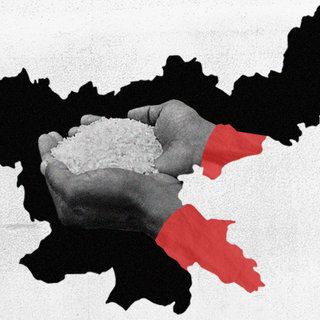
Why Caste Is Essential to Understanding Marital Rape
“The origin of patriarchy in India is based on caste and religion… Brahminical patriarchy has laid down the foundation of an Indian man as a superior person to an Indian woman.”

When the Delhi High Court delivered a split verdict on criminalizing marital rape last week, it prompted dejection and fury among many. Not least for the fact that one of the judges, Justice Hari Shankar, felt that “Introducing, into the marital relationship, the possibility of the husband being regarded as the wife’s rapist, if he has, on one or more occasion, sex with her without her consent would, in my view, be completely antithetical to the very institution of marriage, as understood in this country, both in fact and in law.” While the other judge deemed it to be unconstitutional, the issue still remains in legal limbo for now. But what many conversations around marital rape overlook is its relationship with caste; indeed, this fundamental and violent feature of Indian society is where it all arguably began.
It may sound provocative to say that marital rape is legal for the same reason that inter-caste marriage is forbidden. But these two guiding principles of the Indian family structure have in common a unifying idea: that women’s bodies are owned commodities, signifying caste and honor.
It was Dr. B.R Ambedkar who pointed out that endogamous marriages are an important means of perpetuating the caste system. In his paper ‘Castes In India: Their Mechanism, Genesis and Development,’ he stated that “caste is an enclosed class.”
“In Ambedkar’s formulation, three operations central to the origin and development of caste come to light: intra-group organization of reproduction, violent control of surplus woman’s sexuality, and legitimating control practices through ideology,” wrote scholar Sharmila Rege.
It starts with texts that laid down laws for how caste society should be structured, which, in turn, cemented several norms tying caste, marriage, and consent into an inextricable knot. The Manusmriti lays down the proper rules for eligible marriages — permitting some and forbidding others based on caste — and in every instance, treating women like objects of transfer to maintain the purity of the caste.
With the purity principle thus established, it laid down the laws for people to abide by within marriages. Chief among its dictates was the principle of a wife’s unquestioning obedience to the husband. “Manu advises upper-caste men to guard their women closely so that no other man plants his seed in their wife/woman in order to ensure purity and continuity of caste. If this control over women is subverted, caste dies a quick death,” writes scholar Sowjanya Tamalapakula.
Related on The Swaddle:
Why It’s Still Legal For Indian Men to Rape Their Wives
“… caste determines the division of labor, both sexual division of labor and division of sexual labor,” Rege further wrote.
The issue of consent itself can be traced back to the prevalence of child marriages. Scholar Uma Chakravarti explains how they were integral to the conceptualization of consent as something given by fathers, brothers, or guardians of the bride and groom but never the partners themselves. Child marriage was thus permitted — even encouraged — under Brahminical norms for two reasons: infants or children would not be able to consent to their bonds, thus facilitating a caste-based system of arranged marriages, and infant girls would also be assimilated into their “husbands'” families early on, thereby precluding any resistance. The text was thus instrumental in creating scriptural legitimacy for violent, caste-based ordering of society that depended on erasing the agency and consent of women.
Manjula Pradeep, from the Dalit Human Rights Defenders Network, summarizes it to The Swaddle like this: “The origin of patriarchy in India is based on caste and religion. The entire concept around purity and pollution restricts the freedom of women across castes. Brahminical patriarchy has laid down the foundation of an Indian man as a superior person to an Indian woman.”
Any attempt to change things was met with fierce resistance. Take the fact that in 1872, Act IIIaimed to facilitate inter-caste civil marriages. “…it had much wider application and generated extreme anxiety from caste Hindu society as it made possible marriage across castes, and across religious communities. Most important, it was registered as a legitimate union between two consenting partners without needing the sanction of the families of the couple,” wrote Chakravarti.
This Act was later repealed and replaced by the Special Marriages Act in 1954, which facilitates inter-religious and inter-caste marriages but with conditions attached that give families of either individual enough time to intervene, harass, and prevent the marriage from taking place. Once again, a legal loophole preventing civil inter-faith and inter-caste marriages effectively places consent into the hands of families rather than individuals. “…any relationship based on genuine consent of the partners, is ‘interpreted as a defiance of patriarchal authority and a threat to endogamy,’” as Uma Chakravarti noted.
These intertwining issues of caste, marriage, and consent came to a head again more than 130 years ago when an 11 year-old girl, Phulmoni, died from her injuries after her 35–year-old husband raped her. Phulmoni was the casualty of marital rape that garnered legal attention; the incident eventually led to the age of consent legally shifting from 10 to 12 years old in 1890, but this was accompanied by much furore— from men belonging to privileged castes. Many launched into stringent opposition against raising the age of consent, citing Manu’s laws to substantiate their arguments.
Related on The Swaddle:
Marriage Is an Inherently Unfeminist Institution
The Phulmoni case showed for the first time how Brahminical norms around marriage and consent were based on a foundation of violence, wherein it was girls and women who stood to be harmed the most. “The argument was that it [the Age of Consent Bill] violates a Hindu ritual of garbhadhan, which is that when the wife reaches puberty, within 16 days of that, the husband and wife must cohabit. Otherwise, her womb is contaminated and the children born to her are not allowed to make ritual offerings,” explained historian Tanika Sarkar to The Swaddle.
The womb, then, is the ultimate site of purity and control — and marriage, consent, and caste are all subsumed under its sanctified place under brahminical codes.
Anti-caste assertions against marriage or for marriage reform have therefore always been rooted in resisting its oppressive aspects of it, which are, in turn, rooted in Brahminical patriarchy. Take, for instance, the idea of the self-respect marriage proposed by Periyar E.V Ramasami. “… no odium should be placed on a married woman who desires men other than her husband,” Periyar had famously said.
“The ‘Self Respect‘ movement rejected existing forms of what they considered to be Brahminical marriage… the idea being that caste endogamy… should be abolished,” Mytheli Sreenivas, a historian, told The Swaddle.
Along similar lines, Ambedkar had also argued in favor of birth control for women in the Bombay Legislative Assembly in 1938 — at the heart of these arguments was an opposition to the control over women’s sexuality as enshrined by Brahminical patriarchy and, by extension, even the Indian state.
As we grapple with the implications of being one of the few countries in the world to still debate marital rape, it is essential to locate this particular form of violence in casteism. Doing so would not only be imperative toward recognizing marital rape for what it is, but also challenging the foundations on which the institution of marriage has been built and normalized over centuries: Brahminical patriarchy.
Rohitha Naraharisetty is a Senior Associate Editor at The Swaddle. She writes about the intersection of gender, caste, social movements, and pop culture. She can be found on Instagram at @rohitha_97 or on Twitter at @romimacaronii.
Related


Govt’s Free Rice Scheme May Harm Adivasi Population, Say Jharkhand Activists
